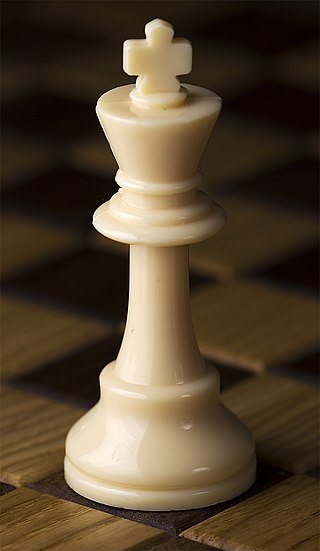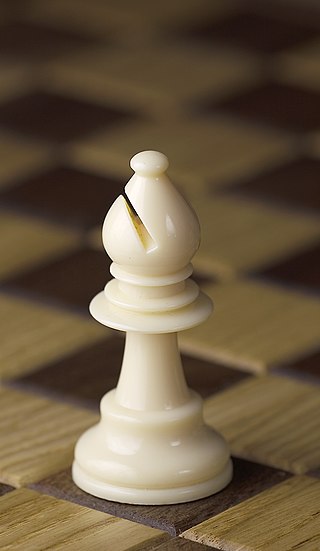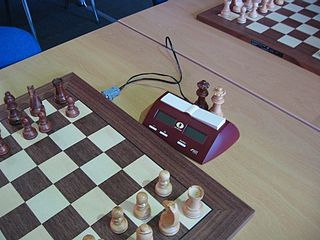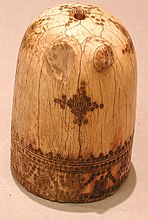
The king is the most important piece in the game of chess. It may move to any adjoining square; it may also perform, in tandem with the rook, a special move called castling. If a player's king is threatened with capture, it is said to be in check, and the player must remove the threat of capture immediately. If this cannot be done, the king is said to be in checkmate, resulting in a loss for that player. A player cannot make any move that places their own king in check. Despite this, the king can become a strong offensive piece in the endgame or, rarely, the middlegame.

The queen is the most powerful piece in the game of chess. It can move any number of squares vertically, horizontally or diagonally, combining the powers of the rook and bishop. Each player starts the game with one queen, placed in the middle of the first rank next to the king. Because the queen is the strongest piece, a pawn is promoted to a queen in the vast majority of cases.

The bishop is a piece in the game of chess. It moves and captures along diagonals without jumping over intervening pieces. Each player begins the game with two bishops. The starting squares are c1 and f1 for White's bishops, and c8 and f8 for Black's bishops.

The knight is a piece in the game of chess, represented by a horse's head and neck. It moves two squares vertically and one square horizontally, or two squares horizontally and one square vertically, jumping over other pieces. Each player starts the game with two knights on the b- and g-files, each located between a rook and a bishop.

The pawn is the most numerous and weakest piece in the game of chess. It may move one square directly forward, it may move two squares directly forward on its first move, and it may capture one square diagonally forward. Each player begins a game with eight pawns, one on each square of their second rank. The white pawns start on a2 through h2; the black pawns start on a7 through h7.
In chess, a pin is a tactic in which a defending piece cannot move out of an attacking piece's line of attack without exposing a more valuable defending piece. Moving the attacking piece to effect the pin is called pinning; the defending piece restricted by the pin is described as pinned. Only a piece that can move any number of squares along a horizontal, vertical, or diagonal line can pin. Any piece can be pinned except the king. The pin is one of the most powerful chess tactics.

The rules of chess govern the play of the game of chess. Chess is a two-player abstract strategy board game. Each player controls sixteen pieces of six types on a chessboard. Each type of piece moves in a distinct way. The object of the game is to checkmate the opponent's king; checkmate occurs when a king is threatened with capture and has no escape. A game can end in various ways besides checkmate: a player can resign, and there are several ways a game can end in a draw.
This glossary of chess explains commonly used terms in chess, in alphabetical order. Some of these terms have their own pages, like fork and pin. For a list of unorthodox chess pieces, see Fairy chess piece; for a list of terms specific to chess problems, see Glossary of chess problems; for a list of named opening lines, see List of chess openings; for a list of chess-related games, see List of chess variants; for a list of terms general to board games, see Glossary of board games.
Capablanca chess is a chess variant invented in the 1920s by World Chess Champion José Raúl Capablanca. It incorporates two new pieces and is played on a 10×8 board. Capablanca believed that chess would be played out in a few decades. This threat of "draw death" for chess was his main motivation for creating a more complex version of the game.
A fairy chess piece, variant chess piece, unorthodox chess piece, or heterodox chess piece is a chess piece not used in conventional chess but incorporated into certain chess variants and some chess problems. Compared to conventional pieces, fairy pieces vary mostly in the way they move, but they may also follow special rules for capturing, promotions, etc. Because of the distributed and uncoordinated nature of unorthodox chess development, the same piece can have different names, and different pieces can have the same name in various contexts as it can be noted in the list of fairy chess pieces.
In chess, a pure mate is a checkmate position such that the mated king is attacked exactly once, and prevented from moving to any of the adjacent squares in its field for exactly one reason per square. Each of the squares in the mated king's field is attacked or "guarded" by one—and only one—attacking unit, or else a square which is not attacked is occupied by a friendly unit, a unit of the same color as the mated king. Some authors allow that special situations involving double check or pins may also be considered as pure mate.
Kriegspiel is a chess variant invented by Henry Michael Temple in 1899 and based upon the original Kriegsspiel developed by Georg von Reiswitz in 1812. In this game, each player can see their own pieces but not those of their opponent. For this reason, it is necessary to have a third person act as an umpire, with full information about the progress of the game. Players attempt to move on their turns, and the umpire declares their attempts 'legal' or 'illegal'. If the move is illegal, the player tries again; if it is legal, that move stands. Each player is given information about checks and captures. They may also ask the umpire if there are any legal captures with a pawn. Since the position of the opponent's pieces is unknown, Kriegspiel is a game of imperfect information.

In chess, promotion is the replacement of a pawn with a new piece when the pawn is moved to its last rank. The player replaces the pawn immediately with a queen, rook, bishop, or knight of the same color. The new piece does not have to be a previously captured piece. Promotion is mandatory when moving to the last rank; the pawn cannot remain as a pawn.
Shō shōgi is a 16th-century form of shogi, and the immediate predecessor of the modern game. It was played on a 9×9 board with the same setup as in modern shogi, except that an extra piece stood in front of the king: a 'drunk elephant' that promoted into a prince, which is effectively a second king. While 9×9 may not seem 'small', it was smaller than the other shogi variants prevalent at the time, which were the 12×12 chu shogi and 15×15 dai shogi. According to the Sho Shōgi Zushiki, the drunk elephant was eliminated by the Emperor Go-Nara, and it is assumed that the drop rule was introduced at about the same time, giving rise to shogi as we know it today.
In chess, the exchange is the material difference of a rook for a minor piece. Having a rook for a minor piece is generally advantageous, since the rook is usually more valuable. A player who has a rook for a minor piece is said to be up the exchange, and the other player is down the exchange. A player who wins a rook for a minor piece is said to have won the exchange, while the other player has lost the exchange. The opposing captures often happen on consecutive moves, but this is not strictly necessary. Although it is generally detrimental to lose the exchange, one may occasionally find reason to purposely do so; the result is an exchange sacrifice.

Hexagonal chess is a group of chess variants played on boards composed of hexagon cells. The best known is Gliński's variant, played on a symmetric 91-cell hexagonal board.
In chess, an exchange or trade of chess pieces is a series of closely related moves, typically sequential, in which the two players capture each other's pieces. Any type of pieces except the kings may possibly be exchanged, i.e. captured in an exchange, although a king can capture an opponent's piece. Either the player of the white or the black pieces may make the first capture of the other player's piece in an exchange, followed by the other player capturing a piece of the first player, often referred to as a recapture. Commonly, the word "exchange" is used when the pieces exchanged are of the same type or of about equal value, which is an even exchange. According to chess tactics, a bishop and a knight are usually of about equal value. If the values of the pieces exchanged are not equal, then the player who captures the higher-valued piece can be said to be up the exchange or wins the exchange, while the opponent who captures the lower-valued piece is down the exchange or loses the exchange. Exchanges occur very frequently in chess, in almost every game and usually multiple times per game. Exchanges are often related to the tactics or strategy in a chess game, but often simply occur over the course of a game.

The following outline is provided as an overview of and topical guide to chess:

Chesquerque is a chess variant invented by George R. Dekle Sr. in 1986. The game is played on a board composed of four Alquerque boards combined into a square. Like Alquerque, pieces are positioned on points of intersection and make their moves along marked lines ; as such, the board comprises a 9×9 grid with 81 positions (points) that pieces can move to.































